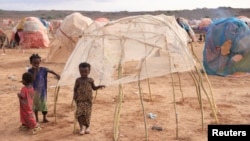Drought is not new to the Horn of Africa, but experts say the record one killing crops and cattle across Ethiopia, Kenya, and Somalia has underscored the increasing frequency of drought due to climate change.
In Ethiopia, the U.N.'s World Food Program is not just feeding those affected but also working to help drought-proof communities for the longer term.
Hawo Abdi Wole has lived through many droughts in her 70 years of life. But until now, she said she had never seen four consecutive rainy seasons fail. Wole said she has seen a big difference. In early years, she said, people used to see more rains and animals produced more milk. There is a big, big difference now.
The World Food Program is helping her village not only survive the crisis but rebuild for the long term.
The group is digging meter-wide, semi-circular holes in the barren soil to capture runoff water when rains return so that grass can grow more effectively and people feed their surviving livestock.
Forward-looking interventions are desperately needed. Scientists say climate change is the culprit for these more frequent, severe conditions.
“The climate in this region is driven by what is happening in the neighboring ocean,” said Abubakr Salih Babiker, who is with World Meteorological Organization in Ethiopia. “There are studies that indicated that this is the world's fastest warming part of the tropical ocean system. So, it is warming rapidly during the past 100 years. And this warming, as I said...it was... it is associated with the dryness of the March-June season.”
It also results in flooding when the rain does return. These events aren’t just examples of climate change, but inequality, said Habtamu Adam, a climate policy expert in Addis Ababa.
“When you compare from the emission level from our contribution to the climate change, it is very incomparable because most of the emissions are emitted from developed countries,” he said.
Yet developing countries like Ethiopia don’t have the funds to fight the effects.
The World Meteorological Organization estimates that sub-Saharan Africa will need up to $50 billion annually to adapt to climate change. Without it, the number of people displaced and in need of aid will only continue to rise, said Ali Hussein, who is with the World Food Program in the Somali region.
“We need to build the community resistance to these shocks and in that line, we want to put more emphasis on these regreening activities, such as half-moons, to regenerate this dry desert area to become a green land in the future, which can be more useful to both communities and as well as livestock," he said.
These projects around the Somali region are showing success and could be replicated to help more people.
Ibrahim Kurbad Farah is an elder of a village that saw its land restored with the construction of a channel that is effectively diverting streams and rainwater. He said they have experienced numerous advantages. They’re now able to farm and use the grass for livestock, as well as thatches for their houses. He said they also use the water for drinking, especially for the livestock.
While adaptation is crucial to communities’ health and survival, climate scientists warn reducing emissions remains a priority in preventing even worse conditions in the future.





